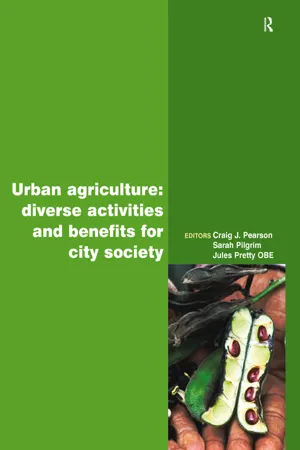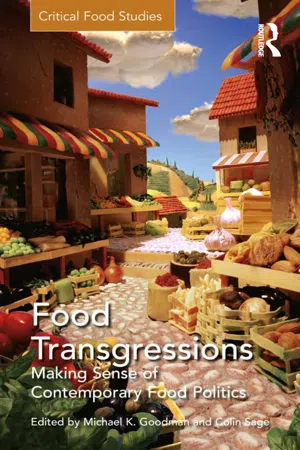Community Supported Agriculture
Community Supported Agriculture (CSA) is a system where consumers directly support local farmers by purchasing shares of the farm's produce. Members typically receive a weekly or monthly supply of fresh, seasonal fruits and vegetables. This model fosters a closer connection between consumers and the source of their food, promotes sustainable farming practices, and strengthens local food systems.
5 Key excerpts on "Community Supported Agriculture"
- eBook - ePub
Local Food
How to Make it Happen in Your Community
- Tamzin Pinkerton, Rob Hopkins(Authors)
- 2009(Publication Date)
- Green Books(Publisher)
...Chapter 8 Community Supported Agriculture In the UK and around the world, Community Supported Agriculture schemes (often referred to as CSAs) are fast becoming recognised as key elements of local food networks, and as efficient, resilient ways of feeding communities. CSAs come in many shapes and sizes but they are in essence farms (often set up as limited companies) in which community members become involved by buying shares, making decisions and even helping to grow and harvest the food they eat. Setting up a CSA can be a larger project than those described in other chapters in this book, requiring much groundwork, knowledge and community support before it can take off. But because the CSA model strengthens relationships between the farmer, the community and the wider environment, there are many benefits that come with the start-up and long-term effort it requires. For the farmers, there is a secure market for the food they produce. For the community members that support them, there is access to local, often organic food, the opportunity to develop their own growing skills and the space to have a say in what is produced and how. Because the food producers are growing for a defined, local market rather than for the unpredictable, global food market, the food miles that their produce travels are drastically reduced and they are able to support wildlife and biodiversity by growing a varied selection of crops. So although the term ‘Community Supported Agriculture’ implies a one-way relationship of support from the community to the farmer, the relationships are actually three-way (between growers, community and the environment) and the benefits flow in all directions. Gaps between the three recipients are closed, understanding is fostered, and each receives the nourishment it deserves (see Amanda Daniel’s article on page 105 for the Soil Association’s views on why CSAs have an important role to play in local food networks)...
- eBook - ePub
Urban Agriculture
Diverse Activities and Benefits for City Society
- Craig Pearson, Sarah Pilgrim, Jules Pretty, Craig Pearson(Authors)
- 2011(Publication Date)
- Routledge(Publisher)
...191) argue that CSA ‘provides a social and economic alternative to the conventional, large-scale, corporately managed food system’. They describe how farmers gain a reliable market and the financial (as well as labour and social) support of members prior to each season, while members receive weekly shares of fresh, locally grown produce 22–52 weeks of the year, depending on the region. As a local institution ‘designed to share the risks and rewards of farming’ (p. 191), CSA can be considered as a ‘form of direct marketing of agricultural products that can be an important facet of a more sustainable, locally based food system’ (Kolodinsky and Pelch, 1997, p. 129). In their paper examining the cultural role of two CSA farms in Illinois, McIlvaine-Newsad et al. (2004) point out that, ‘CSA not only seeks to redefine agriculture, as we know it, but also attempts to establish personal relationships between farmers, consumers and specific places, thus fostering a sense of community…’ (p. 149). In addition, CSA farms aim to meet the broad goals of sustainable agriculture by: ‘providing a wide range of healthy, locally-grown food; reconnecting consumer with producer; and fostering a sense of local environmental and human stewardship’ (McIlvaine-Newsad et al., p. 153). For this reason, CSA farms can provide researchers with a working model for addressing Pretty’s questions: how can we put the culture back into agriculture while contributing to the overall production of food and creating sustainable systems of farming? Methodology and methods: a case study of Fourfold Farm CSA Case studies, according to Babbie (2001), are useful insofar as they allow researchers to limit their attention to a particular social phenomenon in a particular area. In his discussion of relevant situations for different research strategies, Yin (2003) argues that case studies foster a consideration of research questions that ask ‘how’ and develop an understanding of contemporary events or phenomena...
- eBook - ePub
Food Transgressions
Making Sense of Contemporary Food Politics
- Michael K. Goodman, Colin Sage, Michael K. Goodman, Colin Sage(Authors)
- 2016(Publication Date)
- Routledge(Publisher)
...This guarantees an income for the farmer and shares the risk amongst the subscribers. In return, the subscribers get a share of the harvest. This is often an organic vegetable box, but it could also be fruit, eggs or meat. Many CSAs also include elements such as social events and work details for members to help at certain times of year. Some CSAs involve members in decision-making and even in owning the farm (see Soil Association [ 2007 ] for information on the UK; USDA [ 2007 ] and Robyn Van En Centre [ 2007 ] for information on USA CSAs). In the USA there are now over 1200 CSA schemes (Robyn Van En Centre 2007) but in the UK they are still rather rare – the latest available figures suggest that in 2006 there were 30 in the whole country (Cultivating Communities 2006). The number stands to grow, however, with money from the UK’s National Lottery being directed towards supporting the establishment of new CSAs. Whilst advocates of CSA routinely stress ‘localness’ as a key strength, DuPuis and Goodman (2005) raise important questions about whether ‘the local’ is any more likely to be a site of altruistic and caring behaviour, and query the ways that ‘normative localism places a set of pure, conflict-free local values and local knowledges in resistance to anomic and contradictory capitalist forces’ (359). They argue that there are many problems with associating the local with an ethic of care: who gets to define what is local? For whom do you care and how? In their view, the local as a concept intrinsically includes and excludes particular people, places and lifestyles. They question whether localism itself is socially just, and suggest that it can be associated with an ‘unreflexive politics’ whereby a ‘small, unrepresentative group decides what is “best” for everyone and then attempts to change the world by converting everyone to accept their utopian ideal’ (361; see also Feagan 2007, Winter 2003). They cite the work of authors such as Hinrichs (2003; also Allen et al...
- eBook - ePub
50 Ways to Help Save the Earth, Revised Edition
How You and Your Church Can Make a Difference
- Rebecca Barnes(Author)
- 2016(Publication Date)
- Westminster John Knox Press(Publisher)
...Ask what led them into farming, what their farms are like, and what farming methods they use to treat pests and weeds. Knowing this information can help you make decisions as to what to buy. Find out if any local farms sponsor a Community Supported Agriculture (CSA) program. In a CSA, you pledge an advance commitment to buy direct from that particular farm during its growing season. In return, you are ensured a regular supply of fresh produce and the farm is ensured a predictable and sustainable customer. CSAs create a special relationship between farmer and customer, and most CSAs are open to your visiting the farm to become even more familiar with the food you eat. Search http://www.localharvest.org to find a CSA near you. Ask your grocery stores when and where they stock local produce. If they do not, ask them why they do not and if they would consider it in the future. Eat at restaurants that cook with local ingredients. For instance, the Northwest chain Burgerville is a sustainable business that uses seasonal produce (huckleberry milkshakes and Walla Walla onion rings) and purchases local beef from a rancher cooperative in Oregon. These commitments go hand in hand with the company’s purchase of 100 percent wind energy and its transformation of used cooking grease into biodiesel. 1 Walking the Talk In 2000, Rev. John Pitney, a United Methodist pastor in Eugene, Oregon, started the “That’s My Farmer” project, which provides church-based support for local farmers. This growing project supports twelve different farms through nearly twenty faith communities. At First United Methodist Church, where Pitney is associate pastor, fifty families support local farms through CSA shares. Another two hundred people from other faith communities in the area also participate, bringing the total contributions to farmers to approximately $50,000 a year...
- eBook - ePub
- Rattan Lal(Author)
- 2017(Publication Date)
- CRC Press(Publisher)
...The corporate organization of the organic food industry represents a major dilemma for proponents of agricultural sustainability. Highly successful sustainable agriculture ideas will be attractive to private corporations, which will often be successful in diffusing products and practices. At the same time, corporate agricultural sustainability practices may undermine certain aspects of the sustainability agenda (e.g., large-scale monocultural production of organic potatoes in the Northern Intermountain states is associated with a considerable threat of soil erosion and loss of biodiversity). There is considerable debate in the sustainable agriculture community as to whether the best indicator of the growth of sustainable agriculture is the national market share of organic food—much of which is due to the activities of very large corporations such as Whole Foods—or whether the extent of sustainable agriculture is most accurately measured by the prevalence of community-supported agriculture (CSA), farmers markets, local co-ops, community gardens, and direct marketing of food. Those with the strongest commitments to sustainable agriculture are also most likely to see food system localization and the recreation of more local “foodsheds” as the heart and soul of a genuine and enduring sustainable agriculture. [ 9 ] SUSTAINABILITY AS A SOCIAL MOVEMENT Agricultural sustainability is as much a social movement as it is a set of technologies and production practices. Social definitions of sustainability—that is, the concerns, views, ideologies, and agendas of movement participants—are as or more important in shaping what sustainability is as ecological or biological indicators such as soil erosion rates, levels of soil organic matter, biodiversity, and levels of runoff...




